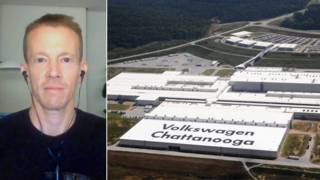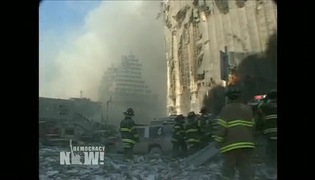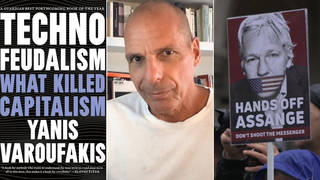
Related
Guests
- Joe Noceraan award-winning journalist and author. He’s a business columnist for the New York Times and a staff writer with the New York Times Magazine. He’s the co-author with Bethany McLean of the book All the Devils Are Here: The Hidden History of the Financial Crisis.
- Scott Paulthe founding executive director of the Alliance for American Manufacturing.
This weekend, thousands of people will gather at the site of the former World Trade Center to mark the 10th anniversary of the 9/11 terrorist attacks. On Sunday, a dedication ceremony will be held for the 9/11 Memorial, which will open to the public on Monday. However, construction continues on 1 World Trade Center, which is far from complete. While the 10th anniversary has made international headlines, little attention has been paid to some controversial aspects of the rebuilding at Ground Zero. At a time when President Obama is launching a massive jobs initiative, key parts of the construction project were outsourced overseas. A Chinese glass company won the contract to manufacture the special blast-resistant glass base of 1 World Trade Center. Some 250 tons of stainless steel from Germany will also be imported for the project. So far, just two tenants have agreed to move in to the 105-floor building, the massive skyscraper formerly known as the Freedom Tower. The China Center was the first tenant to sign a deal. Leasing floors 64 to 69, the center will be used to promote the expansion of Chinese companies in the United States and house the U.S. offices of some Chinese firms. And the publishing giant Condé Nast has agreed to be the anchor tenant by leasing floors 20 to 41 at a heavily subsidized rate. We’re joined by Joe Nocera, business columnist for the New York Times who has closely followed the rebuilding at Ground Zero and recently wrote a column titled “9/11’s White Elephant.” We also speak with Scott Paul, executive director of the Alliance for American Manufacturing. [includes rush transcript]
Transcript
JUAN GONZALEZ: This weekend, thousands of people are preparing to gather at the site of the former World Trade Center to mark the 10th anniversary of the 9/11 attacks. On Sunday, a dedication ceremony will be held for the 9/11 Memorial, which will open to the public on Monday. Construction continues on 1 World Trade Center. Once completed, it will stand 1,776 feet tall.
While the 10th anniversary is making international headlines, little attention has been paid to some of the controversial aspects of the rebuilding at Ground Zero. At a time when President Obama is launching a massive jobs initiative, key parts of the construction project were outsourced overseas. A Chinese glass company won the contract to manufacture the special blast-resistant glass base of 1 World Trade Center; 250 tons of stainless steel from Germany will also be imported for the project.
So far, just two tenants have agreed to move into 1 World Trade Center, the massive skyscraper formerly known as the Freedom Tower.
AMY GOODMAN: The China Center was the first tenant to sign the deal. Leasing floors 64 to 69, the center will be used to promote the expansion of Chinese companies in the United States and house the U.S. offices of some Chinese firms.
And the publishing giant Condé Nast has agreed to be the anchor tenant by leasing floors 20 to 41 at a heavily subsidized rate. According to a recent report in the New York Times, Condé Nast’s rent is less than half the break-even cost of the one million square feet it will occupy. Condé Nast’s rent is just one of many massive subsidies being used to fund the $3.3 billion project, the most expensive office building in U.S. history.
Joining us on the phone is Joe Nocera, award-winning journalist and author, business columnist for the New York Times, staff writer with the New York Times Magazine, co-author with Bethany McLean of All the Devils Are Here: The Hidden History of the Financial Crisis. He’s been closely following the rebuilding at Ground Zero, recently wrote a column called “9/11’s White Elephant.”
Welcome, Joe Nocera. Why white elephant? Explain how exactly the World Trade Center building, that has taken so many years to build, still not finished yet—though, last night, the red, white and blue lights going all up into the sky around the structure at this point—explain who financed it.
JOE NOCERA: Well, the financing is the toll payers who come in from New Jersey to New York City every day to go to work. So, the building is being built by the Port Authority of New York and New Jersey. It’s important to remember that the Port Authority built the first World Trade Center, which didn’t even break even for two decades. The question of why a government agency should be in the commercial real estate business is a question that’s never been adequately answered.
In this particular case, the country, or at least New York and New Jersey, has come to the view—came to the view very early on that rebuilding was important, you know, an important symbol for this country in the wake of 9/11. And, you know, here we are, a decade later. The stuff isn’t finished yet. It’s just been a giant mess. And, you know, it has been extremely, extremely costly, to the point that they just had to raise the tolls. And there’s no question that the burden of this construction is being felt by middle-class people who come in from New Jersey to act as nurses, as nannies, as, you know, the janitors, the mail room clerks. You know, this is on the backs—it’s one more thing that’s on the backs of the middle class.
JUAN GONZALEZ: And Joe Nocera, you’ve also noted in several columns you’ve written on now, for quite some time, that many in the real estate industry of New York scoff at the idea of building this tower, especially since there is an office glut in New York City, of space, and that all of the space was not needed. Yet very few, or none, would go on the record, directly, to be quoted on this—
JOE NOCERA: Well—
JUAN GONZALEZ: —for fear of the reaction.
JOE NOCERA: Well, I mean, there’s a reason Governor—former Governor Pataki used to call it the Freedom Tower. You know, it became a very hard project to criticize. It’s still a hard project to criticize, because it is wrapped up in patriotism and 9/11 and, you know, showing the terrorists that we will not be deterred. Now, I get all that. But on the other hand, they don’t call it the Freedom Tower anymore. They call it, you know, World—WTC1, World Trade Center 1. And the reason they don’t call it the Freedom Tower is because, you know, the Port Authority made a decision that they really want to reposition it as what it is: it’s a commercial real estate building. It’s a high-rise tower. It’s an office tower. That’s all it is. The truly memorial aspect of this is the memorial honoring the dead that now takes up the footprint of the old World Trade Center towers, the old Twin Towers. And I’m told that that’s a very moving, moving memorial. And, you know, to do $11 billion worth of real estate around that seems to me kind of insane.
AMY GOODMAN: And the cost—for example, Condé Nast—you have written about this, getting even tenants to come into this building, how they’re subsidized.
JOE NOCERA: Yeah, well, it’s worse than that. I mean, they hired—they hired the guy who owns the old Condé Nast building to be the manager of the new building, and the first thing he does is lure his old client over there, and he gets a $25 million fee, brokerage fee, just for doing that. And the Port Authority is picking up Condé Nast’s—the remaining years of Condé Nast’s old lease in the old building. So, you know, the rich get richer.
AMY GOODMAN: We’re also joined by Scott Paul, with the Alliance for American Manufacturing. Scott, can you talk about the materials used? I mean, we’re speaking today on the eve of the 10th anniversary of the World Trade Center attacks, also in the aftermath of President Obama’s jobs speech. Talk about the glass. Talk about the steel.
SCOTT PAUL: Well, I would say it certainly serves—the World Trade Center 1 project certainly serves as an emblem of where the American economy is today, which is we’re getting passed by, by China and Germany, particularly on manufacturing. And the challenge with this project is that, you know, at a time that we’ve seen massive unemployment in both construction and in manufacturing throughout—over the last decade—in fact, in manufacturing pre-dating 9/11—the materials that the Port Authority decided to use, many of which came from overseas, in fact are putting American workers out of work.
There was a—PPG, which is a long-standing U.S. company in Pennsylvania, had bid on this highly security-focused, blast-resistant glass. They’re experts at making it. A Chinese company that is owned essentially by the government in China came in at a very subsidized price. The Port Authority chose that contract over PPG in Pennsylvania. And as a result, the blast-resistant glass on the lower floors is coming from China.
The steel, the structural steel, is coming from Europe. And again, this is a contract that the Port Authority awarded to German firms, like Tiessen Krupp, to do the structural steel, when many steel mills in America are sitting idle and certainly could have used the business, and if they were more aggressive about seeking U.S. bids, could have been able to provide the steel for this construction.
The bottom line is that, you know, in addition to the mess that Joe has referred to on the leasing terms, I think this stands as an emblem of the American economy today. George—President Bush’s attitude after 9/11 was go out and shop and be wary of your neighbors, instead of focusing on rebuilding and community and a little bit of sacrifice. And, I mean, with regard to the Port Authority, there was just a real tone deafness about how important it was to try to put people back to work that have been devastated in this economy over the last decade.
JUAN GONZALEZ: Scott, when you mention the fact of a German company being heavily involved in some of the materials, we often hear the argument in this country that these kinds of industrialized union jobs are too expensive to be done here in the United States. Yet Germany, the German work force is highly unionized, very well paid, and still manages to be able to compete in terms of industrial jobs and industrial production. Why is that?
SCOTT PAUL: Yeah, it’s a good question. It’s the right question to ask, Juan. And it is a fact that German manufacturing workers are paid an average of $48 an hour. In the United States, the average for manufacturing workers is $32 an hour. Germany has a national healthcare system. As you know, we do not. Germany has thick regulation, a much more progressive tax system than the United States does, yet Germany thrives in manufacturing. Germany has held its share of manufacturing throughout the last decade, while China has risen, and the U.S. has dramatically declined, in fact by one-third just over the last decade.
And the reason is because Germany has an industrial policy. Its leaders, of all the parties, believe that manufacturing is central to the performance of its economy, and it actually weathered the recession a lot better than the United States has. And there’s a lesson to be learned there, that there is a high road to economic development, where you can build your middle class, have a unionized work force, if you’re willing to put a focus on something like industrial production rather than on oil and gas subsidies or other things that don’t have nearly as much benefit for the American economy.
AMY GOODMAN: Finally, just the irony of the World Trade Center that’s rising at Ground Zero, first having so much trouble attracting any tenants, now has two, one of them being the China Center, which promotes the expansion of Chinese companies in the United States, Scott.
SCOTT PAUL: Well, it is terribly ironic. And the thing that’s troubling to me is that if these Chinese ventures were commercial companies that were competing against American firms on a level playing field, I really don’t have a problem with that. But the fact is, is that the Chinese company that’s moving into this office space, and its tenants, are heavily subsidized by the state, in fact, to the tune of hundreds of billions of dollars. And they will be seeking to locate production of—and do foreign investment in the United States, but it’s not going to be additive to our economy. It’s going to be in direct competition with our clean energy firms who do solar and wind turbines, with our electrical vehicle—electric vehicle firms, and with our industrial sector, as well. And instead of being a net benefit for the American economy—and foreign investment can be a net benefit for the American economy—this type of predatory foreign investment is actually going to make it more difficult for us to create jobs.
AMY GOODMAN: Scott Paul, we want to thank you for being with us, Alliance for American Manufacturing.
SCOTT PAUL: Thank you.
AMY GOODMAN: And Joe Nocera, award-winning journalist and author, business columnist for the New York Times. This is Democracy Now!, democracynow.org, The War and Peace Report. When we come back from break, we’ll talk about the health effects of the World Trade Center attacks on the first responders, 10 years later. Stay with us.












Media Options